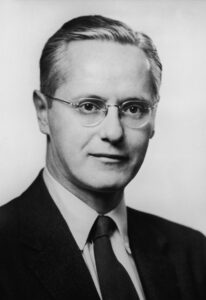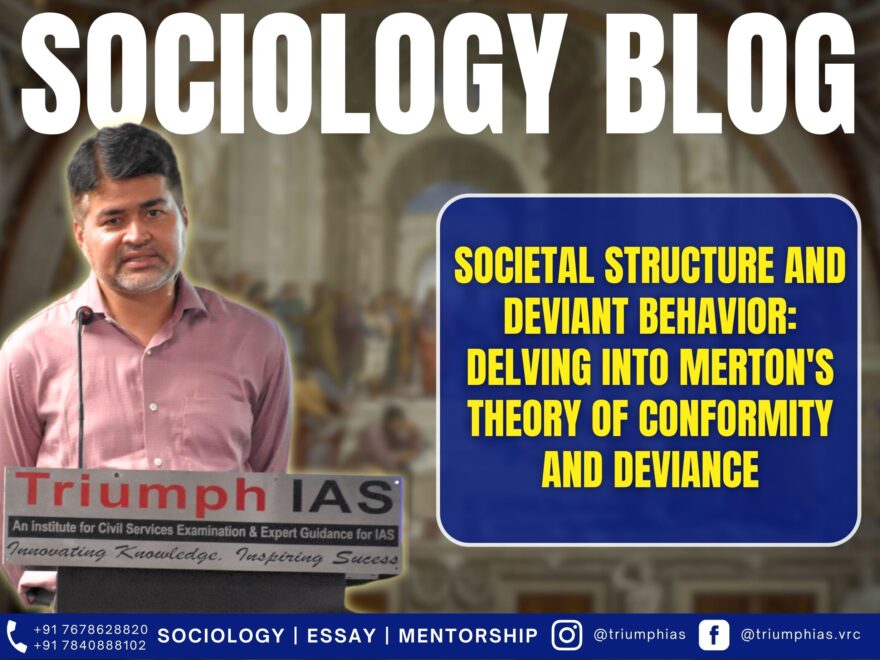
A cardinal American virtue, ‘ambition,’ promotes a cardinal American vice, ‘deviant behavior.
Conformity and Deviance
Relevant for Sociology Paper-1 (Unit-4)
Merton initiates his analysis by asserting that deviant behavior is a consequence of the cultural and structural aspects of society. Drawing from the functionalist perspective, Merton posits that in order for a society to operate smoothly, there must be a consensus of values among its members. However, due to the unequal distribution of individuals within the social structure, such as differences in class positions, not everyone has equal opportunities to fulfill these shared values. Consequently, this unequal situation can give rise to deviant behavior. In Merton’s own words, “The social and cultural structure exerts pressure that leads individuals in various positions within the structure to engage in socially deviant behavior.”
- Merton asserts that a state of Anomie can exist within the social structure, characterized by a lack of coordination between culturally approved goals and the means available to achieve them. Individuals positioned in different social structures may adapt in various ways to this anomic situation. For instance, in American society, the shared goal of success is equated with wealth and material possessions, often referred to as the “American Dream.” While society provides institutionalized means to attain these goals, such as education, talent, hard work, determination, and ambition, Merton suggests that an anomic situation arises when these conventional means do not guarantee success for the average American.
- Merton outlines five possible responses to this state of anomie. The first response is “conformity,” where individuals conform to both the goals of success and the normative means to achieve them. They strive for success through accepted channels. The second response is “innovation,” where individuals reject normative means and turn to deviant methods to attain success. This includes activities like bribery or involvement in illicit deals. Merton argues that individuals from relatively disadvantaged sections of society are more likely to choose this route when conventional means are inaccessible. They abandon institutionalized means but retain aspirations for success.
- The third response, termed “ritualism,” is characterized by individuals who become deviant by obsessively adhering to the means while losing sight of the goals. This response is most prevalent among the lower middle class, who have limited opportunities for success compared to other middle-class members. However, their strong socialization to conform prevents them from resorting to deviant means. Instead, they abandon their aspirations for success and become immersed in adhering to rules and norms without striving for achievement.
- Merton labels the fourth response as “retreatism,” which applies to individuals such as psychotics, artists, outcasts, vagabonds, chronic drunkards, and drug addicts. These individuals have internalized both the cultural goals and institutional means but are unable to achieve success due to the anomic situation. They cope with their circumstances by completely abandoning both the goals and the means to reach them. They withdraw from society, feeling defeated and resigned to their failures. Retreatists reject both the cultural goals and the institutionalized means.
- The fifth and final response is “rebellion,” where individuals reject the goals, means, and institutions altogether and seek to create a new society. Examples include historical figures like Lenin, Christ, and Gandhi, as well as terrorists in various societies. Merton argues that rebellion is often driven by members of rising social classes who organize the resentful into revolutionary groups.
- In conclusion, Merton asserts that his analysis demonstrates how deviance is generated by the cultural norms and the lack of alignment between these norms and the institutionalized means established by society. This disjunction creates pressure for deviant behavior, and the extent of this pressure varies based on an individual’s social class. How individuals respond to this pressure is also influenced by their position in the class structure. Therefore, Merton’s theory offers a sociological explanation of deviance, emphasizing the role of societal factors rather than individual characteristics. Over time, other scholars have expanded and modified Merton’s theory to explain different forms of deviance, broadening the scope of his original theory.
Analysis of Deviance after Merton:
- According to Albert Cohen, Merton’s theories can only account for deviant behavior aimed at financial gain, known as pecuniary deviance. They do not explain acts of senseless violence, vandalism, or non-pecuniary deviance. Cohen argues that such forms of deviance serve as a safety valve for individuals experiencing frustration. For those living in poverty or slums, deviance acts as an outlet when mainstream cultural goals hold no value for them.
- Cloward and Ohlin further criticized Merton’s theory, stating that it fails to explain why individuals resort to becoming innovators or ritualistic deviants. They introduced the concept of criminal subculture, which they believe is solely responsible for deviant behavior.
- Walter Millar suggests that criminals are not always individuals who have failed to find legitimate opportunities. Some engage in deviant acts for the thrill, such as pickpocketing or engaging in boxing.
- David Matza argues that there is little difference between criminals and non-criminals, as both groups uphold societal values. Deviants often try to disown responsibility, using techniques of neutralization to partially accept societal norms. Matza’s theory of delinquent drift suggests that young people may flow into deviant behavior as a way to overcome feelings of helplessness and fatalism.
- Howard Becker proposes the “Labeling Theory,” which asserts that society labels certain behaviors as deviant, and these behaviors become deviant due to the expectations associated with the label. In other words, if someone is given a negative reputation, they are more likely to conform to that expectation.
- Edwin M. Lemart distinguishes between primary and secondary deviation. Primary deviation refers to deviant acts before they are publicly labeled, while secondary deviation is the response of individuals or groups to societal reactions.
- Bernard Lander, a researcher from the Chicago School, conducted a study in Baltimore and found that social disorganization plays a key role in explaining deviant behavior.
To master these intricacies and fare well in the Sociology Optional Syllabus, aspiring sociologists might benefit from guidance by the Best Sociology Optional Teacher and participation in the Best Sociology Optional Coaching. These avenues provide comprehensive assistance, ensuring a solid understanding of sociology’s diverse methodologies and techniques
Conformity, Deviance, Sociology, Merton’s theory, Anomie, Rebellion, Retreatism, Innovation, Ritualism, Labeling Theory, Primary Deviation, Secondary Deviation, Social Disorganization
Follow us :
🔎 https://www.instagram.com/triumphias
🔎https://www.youtube.com/c/TriumphIAS
https://t.me/VikashRanjanSociology
Find More Blogs
|
Scope of the subject and comparison with other social sciences |
|||
|
|
|
|
Modernity and social changes in Europe |

